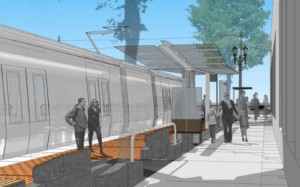Beefed-up fire and police presences, along with fare enforcement, would be provided by C-Tran for light-rail trains and stations when the Columbia River Crossing Light Rail project is built, according to a report presented to the Vancouver City Council.
Matt Ransom, Vancouver’s manager of long-range planning, told council members Monday night that C-Tran will maintain the stations and provide additional security. Ransom explained that there is a standing committee comprised of fire, police, and C-Tran staff exploring the creation of a security protocol for the system. “There might be intergovernmental agreement where we say, ‘You do this, we do this’,” Ransom said.
C-Tran expects ridership on light rail to reach 18,700 daily trips by 2030.
Ransom displayed renderings of light rail stations and the three proposed park and rides. A park and ride at Columbia Street between 3rd and 5th streets will hold 570 spaces. The park and ride at Washington Street between 15th and 16th Streets will have 420 spaces. The largest of the three, the Central Park park and ride at Clark College, will hold 1910 spaces.Though the Columbia River Crossing Light Rail project (CRC) has yet to secure a single penny of $10 billion* in projected construction funds, the City of Vancouver and C-Tran are moving ahead with preparations for the mega project’s arrival.
The CRC will replace the existing Interstate Bridges across the Columbia with two new spans, extend light rail from North Portland into Vancouver by 2.9 miles, reconstruct up to six highway interchanges, and build three large park and ride structures in downtown Vancouver.
Despite the lack of funding, Ransom said that when the federal highway and federal transit administrations issued a joint record of decision in December the project was given a green light to move ahead with more detailed engineering, property acquisition, and construction.
Property owners affected by CRC to be alerted
Speaking on behalf of CRC Director Nancy Boyd, who was unavailable, Ransom said CRC staff is in the process of sending letters to affected property owners to let them know the degree of displacement they will face. These include full or partial acquisition, as well as temporary or permanent easements.
“It’s a very proactive process ensuring that people are compensated for impacts,” Ransom said.
TriMet’s yellow line will run from Portland into Vancouver going north on Broadway Street and south on Washington Street between 5th and 17th streets, with one lane of vehicle traffic moving in the same direction. Trains will also travel about 12 blocks along 17th street to between Washington Street and Clark College. Downtown stations will be near 6th, Evergreen, and 16th streets.
Council member Larry Smith expressed concern over the potential harm that construction could have on businesses, particularly given that there could be simultaneous construction occurring at the proposed waterfront redevelopment site over the next decade.
“How do you schedule that and how do you work with business owners to keep viability on track?” Smith asked.
Ransom said streets will be completely rebuilt block by block, requiring careful traffic control to ensure the greatest level of business access in the downtown core.
“The important thing is it’s not shut down, that traffic is not completely closed,” he said. “Three through lanes on I-5 have to be kept open at all times. For those people who are operating businesses, we’ll be making sure” everything doesn’t happen at once.
City controls CRC construction permitting process
Ransom said the city is hoping to have the CRC fund a lead engineer staff position that could serve as a chief liaison to contractors. Although the city will not be doing any construction, it will still have authority to grant construction permits and to make sure that architectural designs are consistent with city standards.
Jeff Hamm, CEO and executive director of C-Tran, explained that the agency is on target to put a 0.1 percent sales tax increase on the November ballot to generate $4 million to $5 million to run both light rail and a proposed bus rapid transit line on Fourth Plain Avenue.
Council member Jeanne Harris questioned the design of light rail stations having open ticketing stations, rather than “closed” systems, such as those with turnstiles requiring payment to board.“I’m concerned about fare regulations,” she said. “You have to make people pay for it. You are either going to have to make sure there are people to ask or you have to create closed systems so they pay before they get on.”
Freshman councilor Bill Turlay said he wants to see exactly how much city funds would be spent on light rail, particularly due to the fact that TriMet is currently operating in the red ($1.1 billion in unfunded retirement benefit liabilities, alone).
Turlay said he was reluctant to get into a partnership with another transit agency in that kind of shape. “We need to see some numbers,” he said.
* The well-documented cost to taxpayers, if the CRC stays on budget, is $10 billion. This was established by the Cortright Report (PDF) which used data from an independent review panel hired by the governors of Washington and Oregon. (View the panel’s final report.)
See our continuing coverage of the Columbia River Crossing Light Rail project.
Do you have information to share on the CRC? To respond anonymously call 260-816-1426. To allow your comments to be used on COUV.COM call 260-816-1429.












[...] In spite of several supporters claims that the light rail is “safe,” not a major factor in contributing to crime, a February article at Couv.com quotes C-Tran officials assuring us they would provide extra security for Vancouver light-rail trains, stations. [...]